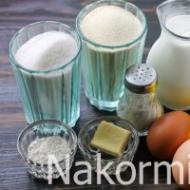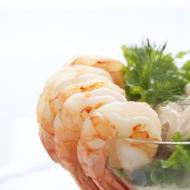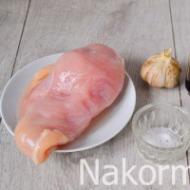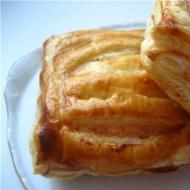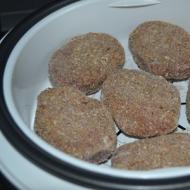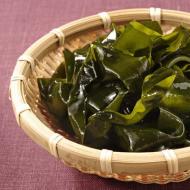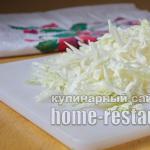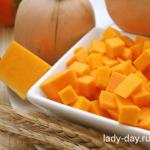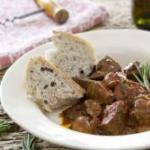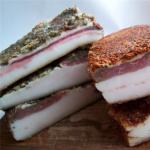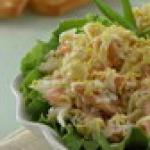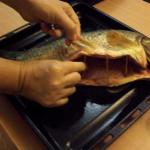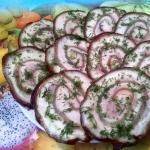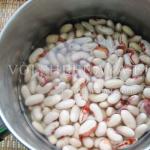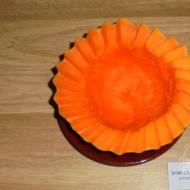
Pork fat: harm, benefits, use, contraindications for use. Useful properties of rendered pork lard
Tallow is a white fatty tissue that covers the internal organs of a pig. The product has a loose consistency. Pork fat is effective in treating colds and more. Before using the component for medicinal purposes, it must be melted. To do this, the fat must be placed in a container and placed in the oven at moderate temperature. The procedure can also be carried out on a gas stove, heating over low heat. Then the pork fat should be drained into another container, separated from the remaining cracklings. The resulting product is called lard. In this form, it is stored much longer and is excellent for treatment.
The healing properties of lard are due to its chemical composition. Despite the fact that the product is animal fat, it contains a small amount of cholesterol, so reasonable intake of the component has a beneficial effect on human health.
The composition of interior lard also includes other substances:
- fatty acids (arachidonic, linolenic, steoric, palmetic);
- vitamins A, K, D, E;
- minerals (zinc, phosphorus, potassium, magnesium);
- lecithin;
- proteins;
- histamines.
The peculiarity of pork lard is that this product does not lose its beneficial properties when heated and heat treated, unlike lamb and beef fat.
Indications for the use of lard for medicinal purposes are the presence of the following diseases:
- bronchitis;
- pneumonia;
- cold accompanied by cough;
- inflammation of the ears;
- pulmonary tuberculosis;
- general exhaustion of the body;
- skin diseases (eczema, burns, dermatitis).
Regular use of the product for preventive purposes normalizes the functioning of the digestive system, removes heavy metals and toxins from the body, and also increases resistance to pathogens.
Pork lard: benefits and harm to the body
2 Contraindications
Pork lard is a high-calorie product, so its excessive consumption can negatively affect a person’s figure or cause food allergies.
Contraindications for use are the presence of the following pathologies:
- duodenitis;
- obesity;
- impaired metabolism;
- pathologies of the liver and pancreas.
Milk thistle oil: beneficial properties and contraindications
3 Use of lard for medicinal purposes
For treatment, it is necessary to use only a high-quality product, which in liquid form should have a transparent amber tint, and when cooled - white. In this case, the interior lard should have a pleasant characteristic odor without any unpleasant hints.
Effective recipes for folk remedies based on this component:
| Purpose | Mode of application |
| Coughing |
|
| Bronchitis |
|
| Pulmonary tuberculosis |
|
| Flu prevention |
|
| Weeping eczema |
|
| Burns |
|
| Runny nose | At night, rub your feet with internal pork fat and put on warm socks. |
| Joint pain |
|
There is a misconception that cholesterol is only harmful to health, but this is not true. This component is especially necessary for a person in stressful situations and during inflammatory processes. If cholesterol enters the body with food, this reduces the burden on the body, since it does not need to synthesize it from internal organs. Therefore, lard is an ideal product to provide the body with vital components.
Milk (kefir, Tibetan) mushroom: beneficial properties and contraindications
4 Features of cough treatment in children
Since not every child with a cold is willing to take medicine, the best treatment option in this case is rubbing with lard, which will get rid of the cough and strengthen the baby’s immunity.
But before rubbing children, you need to learn a few rules for doing it:
- This method of treatment should not be used at elevated body temperature;
- The procedure should be carried out at the age of over 6 months;
- rubbing is recommended to be used in the evening before bedtime;
- The product should be applied to the back, chest and feet;
- after applying internal fat, it is necessary to wrap the child well and put socks on his feet;
- Do not rub the area of the heart.
For therapy, you need to melt the interior lard in a water bath and add 5 drops of fir oil, then apply the product in a thin layer. Repeat the procedure daily until the cough is completely eliminated.
Lard is the fatty tissue of an animal that lines the space of the animal's internal organs. It differs greatly from ordinary lard both in appearance and in its properties. The first difference that catches your eye is its consistency. It crumbles easily, unlike solid pieces of ordinary lard, which can only be cut with a knife. But the differences don't end there.
Internal lard can bring much more benefits to the body than the product to which we are accustomed. Its benefits are so diverse that it is used to treat many diseases.
Composition of pork lard
The various health benefits are due to its rich composition, which contains important nutritional and biologically active components. First of all, despite the fact that this product is animal fat, it contains surprisingly little cholesterol. An excess of this substance in products can cause significant harm to human health. At the same time, it contains an extremely useful substance - arachidonic acid.
Arachidonic acid is a fatty acid that in the human body can stimulate mental activity. It is also extremely useful for people who suffer from increased acidity of the gastrointestinal tract. Therefore, it can bring significant benefits to people who suffer from gastritis or peptic ulcers.
Internal fat is also very rich in vitamins. It contains a large amount of vitamins A, E, K and D. Vitamins are vital substances that the human body can only obtain from food. Vitamin A takes part in the fight against various infections, and is also necessary for healthy hair, skin and nails. Vitamin E prevents the aging of the body, prevents the development of thrombosis, and also strengthens the cardiovascular system. In addition, vitamin A is most effectively absorbed together with vitamin E.
Vitamin K is necessary for the absorption of calcium (which, by the way, is also rich in lard). Vitamin D helps our body fight depression. This product is of great benefit as a means of preventing vitamin deficiency. Especially if you regularly use it in winter.
Also, lard is rich in minerals. Calcium, potassium, zinc, phosphorus and magnesium - these vital nutritional components are contained in large quantities.
The benefits of lard
This product is, without a doubt, one of the healthiest fats. Its benefits remain even with intensive heat treatment. Therefore, it is used as various ointments, as well as warm compresses. Internal fat obtained from pork is very beneficial to the human body. It is rich in vitamins, minerals and other biologically active compounds.
The benefits of internal pork fat are especially noticeable as a means for healing the skin, hair and nails. This product contains all the vitamins and minerals necessary for the health of these tissues. Regular consumption of it improves appearance and also strengthens them.
The benefits of interior lard are invaluable for the treatment of skin diseases, as well as for the treatment of burns. The use of this product on a damaged surface prevents the formation of scars and marks, and also accelerates healing. Regular consumption of it helps strengthen the immune system, improves the body's resistance to infections, and also reduces the likelihood of respiratory viral diseases.
Internal lard for the treatment of diseases
- Joint pain
Using compresses at night, based on internal pork fat, relieves pain in various diseases and joint injuries. Its benefit also lies in improving joint mobility. For joint diseases, it is necessary to apply a special warm compress to them. This requires a fairly dense fabric that retains heat well.
- Skin diseases
Pig visceral fat is an excellent remedy for treating eczema. To do this, use a special mixture based on egg whites, as well as nightshade and celandine.
- Burns
An ointment based on interior lard helps improve the condition of skin with burns. Thanks to its use, the healing of burn surfaces is accelerated, and skin scarring is also prevented.
Ingredients for respiratory diseases
Pig internal fat is of great benefit for diseases of the respiratory system. Our ancestors knew about this and often used it to treat these diseases. Compared to badger or bear fat, which are also used for treatment, pork fat is much easier to obtain. Thanks to its use, expectoration increases, which stimulates a more intense release of microbes during colds. Another important point is its ability to strengthen the immune system.
Before use, it must be melted over low heat. Thanks to this, it acquires a uniform consistency, which makes it much more convenient for use. If the lard was of proper quality, then the smell after this procedure will be insignificant and pleasant. Once cooled, it is already completely ready for use.
A very effective tactic for colds that allows you to fully appreciate its benefits is rubbing. This improves mucus production. Its use is especially important for painful dry coughs. To do this, you need to rub the patient’s chest and back (you cannot rub in the heart area). After this, the patient is dressed in cotton clothes and covered with a warm blanket.
Such procedures allow you to completely cleanse the patient’s lungs in a few days. Internal lard brings even greater benefits in combination with fir oil.
Internal use for colds
Internal lard also brings great benefits as a means to relieve well-being during colds as a means for internal use. Eating a teaspoon of warm visceral fat can help relieve acute coughing attacks.
In addition, it is very useful for colds to mix this product with tea or warm milk. You can add honey to it, which will bring even more benefits. This product must be consumed warm.
Harm of lard
Even such a product, which brings great benefits to people and is used to treat a wide variety of diseases, can also cause harm. Pig visceral fat is harmful to humans, mainly if the animal has been contaminated. To avoid infection with helminthic worms and other microbes, it must be heat treated before consumption.
You should also remember that animal fat is a very high-calorie product and can cause significant harm to your figure. To avoid this, simply consume it in reasonable quantities.
A large amount of fat can disrupt the functioning of the liver and digestive glands in people who suffer from diseases of these organs. Therefore, in case of these diseases, it is better to refrain from using it.
Animal fats are widely used not only in cooking, but also for medicinal purposes. Recipes for their use can be found in books on traditional and official medicine. One of the most versatile varieties in terms of composition and benefits is pork fat, or simply healthy. This is fat-rich tissue from an animal (in this case, a pig), enveloping its internal organs. The beneficial properties of the product and its high healing potential are determined by its rich nutrient content.
Medicinal properties
Pork fat is beneficial for both adults and children. But many people don't even know about it. Therefore, let's look at its properties in more detail.
The first thing worth noting is a relatively small dose of cholesterol, since a large amount of it can cause harm to human health.
The second advantage is the presence of arachidonic acid from the omega-6 fatty acid class. This compound is beneficial for the brain and can increase mental alertness. In addition, it provides medical assistance to people who suffer from gastritis, stomach and duodenal ulcers.
The last nuance is the content of vitamins A, K, E and D. The human body can receive these nutrients in the required quantities only as part of food. Their purpose:
- A – improves the condition of nails, hair and skin, helps the body fight various infections.
- E – rejuvenates the body, preventing its aging, strengthens the cardiovascular system, participates in the absorption of vitamin A;
- K – affects the degree of calcium absorption, plays an important role in hematopoiesis, affects blood clotting;
- D – fights depression, correlates with calcium and glucose levels in the blood, reduces the risk of cancer, strengthens the immune system, and is involved in the formation of bones and teeth.
Due to its composition, pork fat copes well with vitamin deficiency.
Use in folk medicine
The main purpose of pork fat is to strengthen the human immune system. Eating this product primarily serves as an excellent prophylactic against many ailments.
In folk medicine, the use of such fat is usually external. It copes well with mild colds, coughs and chronic bronchitis. Most often used to prepare compresses.
A few recipes and tips for external use:
- rubs for colds are suitable for treating the chest, back and feet; the main thing is not to use at elevated temperatures;
- cough compress: you need to take a bandage or gauze, fold it and soak it in melted fat, put it on your back and cover with a warm towel;
- ointment for rubbing: add 2 tbsp to 50 g of baked health. l. vodka and move carefully.
Recipes for treating cough by oral administration:
- tea for chronic cough: boil milk, add green tea, a piece of lard and black or red pepper on the tip of a knife, drink before bed;
- decoction: add a small amount of zdor to rosehip and bee honey, consume three times a day;
- fat with milk for dry cough: melt a small amount of internal fat in hot milk with honey, drink three times a day.
This is not the entire list of product capabilities. It is used to treat gout and joint diseases, as well as in modern cosmetology.
Cosmetic properties
- A valuable property of pork fat is its ability not to lose its biological value after heating.
- Used to prepare various ointments and creams that support and improve the beauty of the skin. The skin absorbs this product quite quickly, since in some biochemical properties it is similar to human fat.
- Another definite plus is the fast delivery of all the necessary components of cosmetics to their destination due to the high absorbing properties of health.
- The product does not clog the skin, allowing it to breathe as before, and is washed off without much difficulty.
- A huge number of skin care emulsions can be prepared on the basis of pork fat, since it is easily mixed with any other types of fats, as well as with aqueous solutions, alcohols, resins, glycerin and medications.
Harm and contraindications
You can list the contraindications and possible harm from using Zdor on the fingers of one hand.
Pork fat is contraindicated for people who have recently suffered a serious illness or surgery, as a result of which the calorie content of their diet has been reduced and should be restored to normal values gradually.
Those who have liver problems should use the product with caution. The rest are advised not to abuse it.
As for external use, individual intolerance is possible. It can be easily identified if you perform a standard test on a small area of skin (wrist, elbow, etc.).
We buy and melt
Melting internal pork fat is a delicate matter, but for those who are doing this not for the first time, it is quite ordinary.
First, it is important to understand how to choose the right product. Attention should be paid to the following characteristics:
- place of production (homemade fat from a familiar farmer or from your own farmstead is beyond competition);
- appearance (choose fat that is a uniform, soft cream or white shade);
- smell (pungent, specific – a sign of dubious quality).
To melt interior fat into lard in the amount of 3 liters and 1 liter of cracklings you will need: 3.5 kg of high-quality fat, a pan (aluminum), a fire divider.
- You need to take the fat and chop it finely.
- Then put it in a saucepan and put it on fire.
- Stir constantly and strain off the finished mixture.
- Heat until completely evaporated.
Lard can be stored in the refrigerator for up to one and a half years without losing its basic qualities.
Pork fat or ghee?
Pork fat and ghee are natural and quite versatile, easy-to-prepare products that are widely used by housewives in the kitchen.
Differences emerge when it comes to the medicinal properties of these competing foods. The fact is that ghee is aimed mainly at improving digestive processes, while health can not only improve immunity, but also cure a large number of diseases. It turns out that the range of applications of interior fat is much wider.
Other types of animal fats
Many other types of animal fats, which nature has not deprived of beneficial properties, are also used for medical purposes:
- lamb - contains a large set of unsaturated fatty acids, the benefits of which have been proven by modern science;
- goat - in the literature on folk medicine it is recommended for colds and ulcers;
- badger - a universal remedy for the treatment and prevention of bronchitis, pneumonia and other pulmonary diseases;
- bear - has a powerful healing effect on bone problems, muscle pain, cracks, burns, frostbite and strengthens children's immunity;
- snake - used externally for pain of various localizations;
- fish - used as a general health supplement, features: the presence of triglycerides of fatty acids, a generous source of vitamin A.
If you are concerned about the health of your family and are trying to find a universal remedy for many ailments, a small jar of rendered lard in your medicine cabinet may come in handy.
Read also: Bear fat - medicinal properties and contraindications.
Pork and lard are widely used in folk medicine due to their medicinal properties. These products are most popular in the fight against colds and restoration of damaged skin. Most often, various compresses and lotions are prepared using lard. The products are especially beneficial for children's health. When preparing folk remedies, it is recommended to strictly follow the instructions for their use, and before use, be sure to obtain the approval of a qualified specialist and clarify contraindications.
1 Pork lard
The product is a fatty dense mass deposited under the skin of pigs. Since ancient times it has been used for culinary, cosmetic and medicinal purposes.

Health benefits of lard and its use in folk medicine
1.1 Composition and properties
Lard contains a number of substances and compounds beneficial to the body:
- vitamins A, B, C, D, E, F, PP;
- copper;
- iron;
- calcium;
- magnesium;
- sodium;
- zinc;
- selenium;
- phosphorus;
- potassium;
- proteins;
- fatty acid;
- carotene;
- lecithin.
The most beneficial properties of lard include:
- treatment of colds;
- restoration of the skin, including after injuries;
- elimination of vitamin deficiency;
- strengthening the immune system;
- saturating the body with fats and cholesterol;
- improvement in diabetes;
- increased energy;
- normalization of intestinal function.
Medicinal properties of eucalyptus and use in folk medicine
1.2 Treatment of diseases
Pork lard is a common component of folk medicines used in the fight against a number of ailments. The product is used for both external and internal use.
Dead bee and its use in folk medicine
1.2.1 External use
This method involves using pieces of lard as a basis for compresses, lotions, etc. Recipes:
|
Indication |
Usage |
|
Toothache |
A small piece of lard is applied to the sore tooth on the cheek side for 30 minutes. |
|
Lard is applied to the damaged area of the body |
|
|
Sore joints |
The product is applied to the sore part of the body and left until it becomes thinner. |
|
A piece of lard is applied to the inflamed joints and, secured with a bandage, left overnight |
|
|
Ulcers |
The product is carefully rubbed into the wound area, being careful not to damage it. |
|
Shredded or sliced lard is applied to the breast to stop the inflammation process. |
|
|
|
|
Cracked heels |
Pieces of unsalted lard are applied to the heel, previously steamed and scraped |
Lard is also found in various medicines used externally:
|
Indications |
Compound |
Preparation |
Use |
|
Heel spur |
|
|
|
|
Unhealed wounds |
|
|
Lubricate the sore spot 2-3 times a day |
|
Joint injuries |
|
These components are mixed together |
The finished mixture is rubbed into the area of the sore joint and tightly wrapped with a thick cloth, leaving overnight |
|
Warts |
|
The ingredients are mixed together in a ratio of 2:1 |
|
One of the most effective pharmaceutical medications is an ointment against varicose veins, which is prepared on the basis of lard.
1.2.2 Internal use
Of all the recipes for using lard for internal use, the following are considered the most effective:
|
Indication |
Preparation |
Use |
|
Tuberculosis |
A spoonful of melted lard is diluted in a glass of milk. |
Drink the drink in the morning on an empty stomach. |
|
|
|
|
Haemorrhoids |
|
Suppositories are cut out of the frozen product, similar to pharmaceutical ones, and placed in the anus until completely dissolved. |
|
Bile infusion |
Lard is prepared according to the standard procedure |
Eat 15-20 g of product daily |
Eating a small amount of lard before meals can suppress your appetite, which helps prevent overeating and the accumulation of excess weight. In case of rapid intoxication, it is recommended to use it as a snack for alcoholic drinks.
Pork lard contains a significant amount of slow carbohydrates that are absorbed throughout the day. Thanks to this, it is possible to normalize the functioning of the gastrointestinal tract, which is useful for children.
1.3 Contraindications
In order not to cause harm to your health, you must refrain from consuming lard if you have the following diseases:
- gastritis;
- ulcer;
- liver diseases;
- obesity;
- atherosclerosis;
- diseases of the cardiovascular system and gastrointestinal tract.
2 Gastrointestinal fat
Lard is a lumpy, bright white fat used for the outer covering of the internal organs of animals. Unlike ordinary lard, it does not look like a solid mass, but is colored.

2.1 Composition and properties
The healing components and properties may vary depending on the type of fat, but the following ingredients are common to most types of lard:
|
Name |
Properties |
|
Arachnidic acid |
|
|
Vitamin A |
|
|
Vitamin D |
|
|
Vitamin E |
|
|
Vitamin K |
|
2.2 Preparation
In order for the product to be used in traditional medicine, it must first be melted. This procedure is performed according to the following algorithm:
- 1. Lard is cut into small pieces and placed in a saucepan.
- 2. Place the container with the product in the oven at low temperature or on the stove.
- 3. The cracklings are removed from the lard, and the fat is transferred to a separate container and allowed to cool.
- 4. As it cools, the product will acquire a homogeneous consistency with a subtle odor.
An unpleasant, powerful aroma indicates that the lard is old or of poor quality; it is not advisable to use it for medicinal purposes.
2.3 Use in folk medicine
Gastrointestinal fat is used in the treatment of various diseases. External use of the product is usually carried out in the fight against cough and related ailments (tuberculosis, sputum, colds, etc.). In this case, the following types of lard are used:
- pork lard;
- goose fat;
- badger fat;
- lamb lard;
- goat fat;
- bear lard;
- dog fat.
Lamb fat is not consumed for diseases of the gastrointestinal tract, atherosclerosis, or pathological diseases of the urogenital tract.
2.3.1 External and internal use
When used externally, lard is often used as one of the components of medicinal mixtures in the fight against colds. The most effective recipes are presented in the table:
|
Compound |
Preparation and consumption |
|
Goat fat and honey in equal proportions |
|
|
Goose fat and chopped onion in a 1:1 ratio |
The mixture of ingredients is applied to the chest and neck, after which the patient is wrapped in a blanket |
|
|
|
A mixture of these components is rubbed into the chest for bronchitis. |
|
|
Internal lard has the ability to warm up, as a result of which it is prohibited to use it at elevated body temperatures.
There are a number of recipes for preparing folk remedies to combat coughs and colds for internal use. This method is only suitable for patients over 3 years of age. Recipes:
|
Indications |
Compound |
Preparation |
Use |
|
Infectious lung diseases |
|
|
Take 80 g of the prepared product 3 times a day |
|
These ingredients are mixed in equal proportions |
Half an hour before the next meal, take 50 g of the drug orally |
|
|
Cold with cough |
|
|
The drink is drunk at night |
|
Tuberculosis |
|
|
Take 10 g of the product three times a day on an empty stomach. |
In addition to treating colds, visceral fat is also used in the treatment of skin and joints. The most effective recipes are presented in the table:
|
Indications |
Compound |
Preparation |
Use |
|
Sore joints |
Pork fat |
The product is melted according to the standard scheme |
The damaged joint is generously lubricated with lubricant, wrapped on top with compress paper and thick cloth. |
|
Impaired joint mobility |
|
Both components are mixed together |
The finished product is rubbed into the joint, wrapped in a warm cloth. |
|
Weeping eczema |
|
|
The finished product is rubbed into damaged areas of the skin. |
|
|
The prepared mixture is applied several times to the burned part of the body. |
1.3 Contraindications
- excess weight;
- metabolic disorders;
- diseases of the pancreas and liver;
- duodenitis.
If there is no positive effect from eating lard for a long time, you must stop treatment and visit a doctor.
Pork fat is a product of natural origin that supplies energy to the human body and the vitamins it needs. But in everyday life there are different points of view regarding its beneficial properties and contraindications for use.
- We recommend reading:
Some admire its cosmetological and therapeutic effects, while others are categorically convinced that the product only brings harm to our body.
Pork fat is a homogeneous mass of white or cream color with no peculiar odor. It is obtained by melting it or from internal and subcutaneous fat, including scraps. Interior fat has a characteristic odor, which is why it is processed separately from other types.
The product contains 99.6% fat, as well as vitamins A, E, D, K. It is especially rich in carotene and minerals (phosphorus, potassium, calcium, sodium, magnesium, and to a lesser extent, iodine and copper). The caloric nutritional value of the product is quite high: per 100 g – 896 kcal. Pork fat combines several triglycerides of fatty acids essential for strengthening the immune system, such as:
- Linoleic;
- Stearic;
- Palmitic;
- Oleic.
Its advantage is the predominance of arachidonic acid in its composition. Acid promotes the natural metabolic process in the body.
Benefit
The benefits of pork fat are assessed by its components - animal fats that a person needs for normal life and beautiful skin.
Nutritionists have proven that foods fried in melted fat can be absorbed by the stomach much better and faster than those cooked in. It does not lose its biological value during heat treatment.
The benefits of pork fat allow it to be used to improve health and beauty. Masks and face creams made on the basis of this product are quickly absorbed by the skin. When mixed with other medicinal components, all substances are freely broken down and enter the body. The product does not interfere with the breathing of the skin, does not irritate it, and is simply washed off with warm water and soap.
Harm
Most nutritionists say that The harm of pork fat lies in the large amount of cholesterol accumulated in the product. Abuse of cholesterol can provoke vascular atherosclerosis. Therefore, it should be excluded from food.
- We recommend reading:
The second disadvantage that proves the harm from consuming this fat is the saturation of lard with toxic substances, since during the pig’s digestive process they are not passed through the liver, but accumulate in the final product.
The harm from eating pork fat is characterized by metabolic failure. This is explained by a continuous hungry state, since to absorb this product the body uses glucose, which should be aimed at stimulating brain activity. In other words, a person wants to eat all the time, despite impressive fat reserves.
Mycotoxins that arise in the product as a result of the life cycle and decomposition of fungi cause significant harm to our body. These elements cause human poisoning and have a depressing effect on the immune system. But the main danger from eating pork fat is a fungal poison known as ochratoxin. The poison is produced in the pig's organs during slaughter.
Methods of application
There are many folk tips for the internal and external use of pork fat. Despite the established point of view about the harmfulness of pork, you can find diets in which it is considered an important ingredient of the diet. The most famous among them is.
Eating it promotes the absorption of fat-soluble substances (B1, B3, B6, B12). All dietary options that include pork fat are short-term.
Everyone knows that a person gets better not from the pork itself or its by-products, but from the amount of food consumed. Therefore, it even takes into account the permissible daily intake of pork fat, which is 10 g per day. The share in the daily diet should be 30% or 60–80 g per day, of which only a third are plant-based. The ratio of polyunsaturated, saturated and monounsaturated acids required by our body is present in lard.
For those who suffer from dystrophy and dream of gaining a few extra kilograms, doctors advise taking lard orally every day.
Pork fat is popular both in cooking and in the cosmetics industry. Those who want to rejuvenate their facial skin and get rid of wrinkles will benefit from masks that use oak bark, linden flower stalks and dill seeds as additional ingredients. Dry skin problems will disappear when you apply a mixture with sage or parsley juice.
It is important to use a fresh product of proven quality. It is not at all difficult to obtain it at home. Despite all the arguments of opponents of the use of this product, its benefits significantly outweigh its harmful properties.
THESE ARTICLES WILL HELP YOU LOSE WEIGHT
Your feedback on the article:
Pork fat is rendered internal pork fat and lard, i.e. subcutaneous fat. For a long time, pork fat, along with other animal fats, has been criticized by scientists and doctors, blamed for increasing the risk of cardiovascular disease, high cholesterol and other ills. Today fat has been rehabilitated and is once again entering culinary practice. True, buying animal fat in the store is still problematic. It is much easier to heat it yourself at home. How to render pork fat will be discussed in this article.
What are the benefits of pork fat?
For many years, the refusal to use pork fat was explained by the risk of high cholesterol, which is the main cause of heart and vascular diseases. It was classified as one of the most unhealthy fats and all our attention was paid to vegetable oils. Now many studies show that they do much more harm than good.
Animal fats consist of saturated, monounsaturated and polyunsaturated fatty acids. Most of the monounsaturated fatty acids are oleic acid, an acid that is abundant in olive oil. It is for its high content of oleic acid that this oil is considered one of the healthiest vegetable oils.
Saturated fats are also important for the human body. We need them to absorb and assimilate fat-soluble vitamins and some other nutrients. For example, when we drink skim milk fortified with vitamin D, it will not be beneficial because it requires saturated fat to be absorbed. And if there is not enough of it, then no vitamin will be absorbed.
In addition, pork fat is rich in vitamins A, E, Omega-3 fatty acids. Not only that, but this fat helps absorb and absorb these important nutrients and vitamins.
The low level of polyunsaturated fatty acids in pork fat means that the fat oxidizes slowly and does not become rancid, i.e. it can be stored for a long time.
Pork fat has a high smoke point, i.e. it can be heated to higher temperatures without fear of releasing carcinogenic substances. It is suitable for frying at high temperatures that many vegetable oils cannot provide.
Which lard to choose
Pork lard is not uniform in quality. For different needs you need to take different lard for rendering fat.
Firstly, the quality of the fat depends on what and how the pig was fed.
Secondly, from which part of the pig carcass will you render the fat?
To make it easier to figure out which fat is best and for which culinary needs to render fat from which part, take note of these tips.
Lard or lard. This is subcutaneous lard, which is usually salted. But it can also be taken for reheating. It is sold in the market or in the store in pieces. This lard is great for frying and stewing.
Fat from the belly or underbelly. Soft layered fat with meat. Bacon is mainly made from this part. This lard is suitable for frying.
Internal lard or internal fat. This is the fat that is located on the internal organs of the pig. It is cut in layers and is soft. This is the purest fat. After melting, the fat will be white, practically odorless and tasteless. 
The fat rendered from such lard is highly valued by bakers. It is added to the dough, greased with pies to get a fragrant, beautiful crust. It always remains soft.
How to render pork fat at home
The technology for preparing and rendering pork fat is the same regardless of which part of the carcass you are rendering it from.
You can render fat on the stove, in the oven, or in a slow cooker. There are two different ways to obtain fat.
Wet method. Place the chopped fat in a saucepan with a little water. Turn on the stove and bring to a boil. Reduce until the water simmers and melt the fat until it melts in the water. Cool and pour into a jar. This method is suitable for both rendering internal fat and lard.
Dry method. This method can be used to render fat on the stove, oven, slow cooker, or frying pan. Heat the container in which you will heat the fat and place the chopped fat in it. This method can be used to render both interior fat and lard. While rendering fat using this method on the stove or in a slow cooker, stir it periodically with a wooden spatula.
How to render lard into fat
First you need to cut into small cubes, no larger than 1x1cm. Like this 
The finer the lard is cut, the faster it will melt and the more finished fat you will get. You can grind it in a meat grinder.
Place the chopped lard into a saucepan. Add water. For 1.5-2.0 kg of lard, approximately 200-300 grams of water.
Cover with a lid and place on the stove. As soon as the pan is well heated and the first bubbles appear on top, reduce the heat. Fat should be rendered at the lowest possible temperature. When rendered at high temperatures, fat melts faster, but it turns out darker in color, and may even be brown.
Approximately once every half hour, the fat should be carefully mixed with a wooden spatula. The entire process of rendering this amount of lard can take from 4 to 5 hours.
Strain the rendered fat through a sieve to separate the cracklings and pour into clean, dry jars. Once it cools to room temperature, put it in the refrigerator.
How to render pork fat in the oven
The best thing about melting fat in the oven is that you prepare it, put it in a pan, and you can go about your business while the fat is melting.
The preparation of fat is the same as for rendering on the stove. First you need to finely chop the pieces of lard or interior fat. The smaller the better. You can twist it in a meat grinder.
Place everything in a pan that can be placed in the oven. It is good to heat in cast iron.
Preheat the oven to a temperature of about 105-110 degrees. Place the pan in the oven. The rendering time depends on the amount of lard. The more lard, the longer the fat is rendered. You can carefully remove the pan and stir. Just be very careful so as not to burn your hands with fat.
Separate the rendered fat from the cracklings and pour into glass jars.
How to render internal pork fat
Internal fat is soft and layered. Almost all of it is melted away.
Cut the fat into small pieces. Place in a saucepan.
Add approximately 500-100 ml of water depending on the amount of fat. You don't need to pour a lot of water. It turns out to have a softer consistency compared to fat from rendering lard.
Place on the stove over low heat. After about an hour, check the pan and stir. It is very important not to let the fat burn at the very beginning. 
When melting, it will form cracklings, which will gradually settle to the bottom.
Strain the melted fat through a sieve or cheesecloth and pour into jars.
Regardless of what you render the fat from, the most important thing at the initial stage is to clearly regulate the temperature. If the stove is heated too much, the lard may burn.
Until the first rendered fat appears, you need to monitor this process and stir the lard in a timely manner.
As soon as a certain amount of fat is rendered, the remaining pieces will boil in it, giving off fat.
You need to stir periodically. This will ensure that all the pieces of lard are rendered more evenly.
There is no need to render the fat until the cracklings are crispy. They should remain soft and light. They can then be further fried separately until they become brown and crispy. They can be used for stewing potatoes or other dishes. Fried cracklings can be sprinkled, for example, on potato salad.
Properly rendered fat in a glass jar should be pale yellow. When it hardens, it will turn white.
Before pouring it into jars, cool the fat so that the jars do not crack and your work is not in vain.
Fat should be stored in a cool place. Can be frozen.
Pork fat can be stored in such conditions for a long time, more than a year.
How to use pork fat
Pork fat can be used in the same way as vegetable oil. You can fry meat, vegetables, and stew in it. The dough is made with pork fat. Only for baking it is better to take only internal fat and preferably in the area of the kidneys.
Is pork fat beneficial or harmful to humans? Disputes on this issue have been going on for decades. Some are sure that it contains a lot of useful things, while others, on the contrary, are categorically determined that fat only brings harm to the entire body.
Pork fat can not only be consumed internally, but also used to make medicinal ointments, as well as cosmetic supplements.
Is pork fat only harmful to the body?
When studying the hydrolysis of pig fat and how it is absorbed by the human body, it turned out that it is difficult for organs to utilize it. Such fat does not undergo hydrolysis, but is only deposited. To process pig fat, the human body resorts to glucose, which is very important for brain function. Therefore, a person feels an incessant feeling of hunger. Because of this, it results in walking in circles when there are fat reserves, but the person is constantly eating something and cannot get enough of it.
There is also a serious danger of harm to health if the meat is poisoned with mycotoxins - this is the result of the vital activity and decay of fungi. Mycotoxins can cause immunosuppressive and cytotoxic effects. After the death of an animal, ochratoxin, a fungal poison, accumulates in its blood and other organs. He represents the main danger.
Pork fat – is there any benefit to the body?
If you compare pig fat with sunflower oil, it has lower thermal conductivity. It also contains organic components, due to which pork fat cannot be eaten as part of the diet. But at the same time, pig fat is considered the most popular animal fat that can be consumed.This product contains a lot of useful microelements. The vitamin A content in pig fat is up to 0.15 mg; linoleic acid is also necessary for the human body. Pig fat contains little cholesterol - only 50 to 80 mg.
Pork fat is often used externally (it is used as an ointment) and is also taken orally. It is recommended to use it for various diseases. For example, bronchitis, ulcers and burns, if the body is exhausted or there is pain in the ears, and so on.
What properties does pig fat have?
The white mass has almost no odor. Pork fat consists of several acids. The basis is palmitic and stearic. Experts assure that there are more beneficial acids in pig fat than even in hard cheeses. Thus, in terms of biological activity, the benefits of this product are several times greater than, for example, beef or butter. Pork fat is heated, and the quality remains the same. Unlike beef fat.
Based on this product, a large number of useful ointments are prepared for the whole body. This medicine is quickly absorbed and removed from the body with soap. Fatty acids and wax interact well with such fat. It is best to use melted fat, because solid fat tends to oxidize, and it reacts faster with copper and zinc. By the way, soap was the first to appear in exactly this way.
Storage
Pork fat should not be exposed to air for a long time, at high temperatures, or in direct sunlight, because after a while it develops a repulsive odor. This is called rancidity of fats.
Good quality melted fat should be clear or slightly golden in color. If it is frozen, there should be no sediment in its consistency and the color should be white.
The shelf life of fat in a cold room can be up to one and a half years.
How to use pork fat for treatment?
- If your joints hurt badly, you need to lubricate them with pork fat before going to bed, wrap the sore spot with a thick bandage and wrap it with a scarf on top. Remove the compress only in the morning.
- After an injury, there are cases when the joints lose their former properties and move poorly, you need to mix a tablespoon of salt and half a glass of fat. Rub the resulting mass into the affected joint, and then let the leg warm up. This can be a special bandage or a tight bandage.
- If a burn occurs due to carelessness, melt half a liter of pork fat and fry the onion until it turns black. Everyone cools down a little. Then 5 tablets of ordinary acetylsalicylic acid, which is always in the medicine cabinet, are ground into powder and mixed with onions and fat. Popularly this acid is simply called aspirin. When everything is ready, you need to be patient - you will have to smear the burn site often, and not forgetting. There is no need to apply a bandage on top. Aspirin has an antipyretic and bactericidal effect, and fat prevents the appearance of a burn mark. If you constantly apply this ointment to a burn, you should wait two weeks and the skin will be renewed, not a trace will remain of the scars. You just need to endure a little inconvenience - you need to smear the burn once an hour. If the ointment remains and is no longer needed, it is left in a cool place.
- If you suffer from weeping eczema, this mixture will help, which includes two tablespoons of pig fat, 2 pcs. chicken proteins, 100 gr. nightshade and a liter of celandine water. The fresh mixture, after mixing well, is infused for two or three days, and then applied where needed.
How to melt pork fat
- It is necessary to cut the lard, then melt it in a saucepan, reducing the heat. The fat should become transparent. After this, the fat is passed through a sieve with large holes into another container, salted, tossed in the onions and cooked until the onions turn yellow. After this, filter again through cheesecloth, cool to twenty degrees, and then put it in the cold.
- The lard is melted in a saucepan, stirring constantly. This is necessary so that it does not burn. Then pass through cheesecloth or a sieve and leave in a warm place until the onion is at the very bottom. The lard will turn white, after which it is again passed through two sieves into jars. This preparation is perfect for stuffing dumplings or delicious meatballs.
Contraindications
Pork fat should not be used if a person suffers from cholecystitis, hepatitis and duodenitis.
Video: how to render internal pork fat
No fat has probably come under as much criticism from doctors and scientists as pork fat. It has been made one of the most harmful products to human health. Used for many hundreds of years until the beginning of the 20th century, pork fat gradually fell into obscurity, and today it is rare for any housewife to have a jar of this fat in her refrigerator. Is it really so harmful or are all fears far-fetched? Let's talk in more detail about the benefits and harms of pork fat.
In recent years, it seemed that this product was doomed and should completely disappear from our lives. And all this thanks to pseudo-experts who talked about the advantages and disadvantages of saturated, unsaturated and trans fats. Fortunately, in recent years all these conclusions have been questioned and studied in more detail. It turned out that pork fat has no trans fats and is lower in calories than butter and does not lead to artery blockage. And pork fat gradually began to return to our kitchens.
What is pork fat
Until the beginning of the last century, pork fat was one of the main types of cooking fat. They fried it and added it to the dough. And what a delicious crispy crust the chicken gets when greased with pork fat!
Pork fat began to fade into even greater oblivion with the invention of margarine, which was presented as a healthy alternative to fat.
Margarine is a vegetable fat that is solid at room temperature due to the process of hydrogenation.
This production method creates trans fatty acids, which are now said to be a source of high cholesterol. These non-natural compounds can also have adverse effects on cell membranes and the immune system, increasing the risk of inflammation in the body, cancer, and accelerating aging.
After the end of World War II, the consumption of pork fat, along with other animal fats, began to fall even further. It has gotten into the minds of many that they are the main cause of high cholesterol and related diseases.
Fortunately, recent research has found no link between saturated fat and either high cholesterol or cardiovascular disease. And there is no scientific evidence yet that pork fat is most to blame for this. Perhaps this is for the best. Indeed, despite all the “sins” and accusations of this type of animal fat, many restaurant and cafe chefs continued to prepare their masterpieces using it.
Pork fat is rendered lard. The lard, cut into small pieces, is gradually heated to separate the fat from the protein. The latter is also called cracklings, a very tasty by-product when lard is rendered.
Pork fat composition and beneficial properties
Refined pork fat differs in composition from lard. In terms of fatty acids, it is better than butter. Pork fat consists of:
50 percent monounsaturated fatty acids;
40 percent saturated fatty acids;
10 percent polyunsaturated acids.
Butter contains only 45 percent monounsaturated fatty acids. A high percentage of monounsaturated fats is associated with a lower risk of cardiovascular disease.
Most of the monounsaturated fatty acids in pork fat are:
Oleinova;
Palmitinova;
Stearinova;
Linoleva.
In addition, it contains archidonic acid, which is also an unsaturated fatty acid. This acid plays an important role in the synthesis of many hormones, cholesterol metabolism, and heart muscle enzymes.
Lard contains almost twice as much oleic acid as the same butter. This acid is found in large quantities in olive oil, which is one of the healthiest vegetable oils. Oleic acid lowers cholesterol levels in the body, preventing cholesterol plaques from depositing on the walls of blood vessels. This acid is also called Omega-9. 
The percentage of polyunsaturated fat depends on what the pigs were fed. The more grains and plant foods are present in their diet, the lower their content will be.
Lard is the second largest nutritional source of vitamin D, taking pride of place after cod liver. One tablespoon of fat contains 1000 IU of this vitamin.
Vitamin D is a fat-soluble vitamin. Therefore, in order for it to be absorbed by the body, saturated fatty acids must be present in the diet. Lard is an ideal option in this regard and provides the body with all the necessary cofactors.
The amount of vitamin D depends on the conditions under which the pigs are kept. In order for it to be produced and accumulated, pigs must receive sunlight.
In addition to vitamin D, pork fat contains vitamins K, A, and E.
Let us now consider the beneficial properties of this fat from a culinary point of view.
Pork fat has a higher smoke point compared to some vegetable oils, e.g. it is more heat stable. This means that it can be heated more strongly and does not form carcinogenic substances. Its boiling point is about 190 degrees.
Saturated fats have simple single bonds between all the molecules in the fatty acid chain and are therefore more heat resistant than double bonds. Polyunsaturated fatty acids are the most heat unstable. When such bonds are broken, the process of fatty acid oxidation occurs.
Oxidized fats are free radicals that damage cells and their amount in the body should be minimized.
Thanks to this property, it can be used for deep-frying, in batter, and added to dough when baking various flour products, including cookies. When fried, a golden brown crust forms.
Pork fat does not have a distinct smell or taste compared to, for example, lamb fat.
Pork fat benefits
Pork fat is not only a culinary product that can be used for frying, stewing, and baking. It has long been used for medicinal purposes:
For joint diseases;
Skin diseases: irritation, peeling, burns, etc.;
They were treated with:
It combines well with other oils and fats, beeswax, glycerin, and alcohol.
They rub sore joints. Mixed with beeswax, it was used to restore joint mobility. They make ointments with it to treat eczema and burns.
It was once used as fuel in lamps and for making candles, as a lubricant. Pork fat is the best fat for cast iron skillets.
Tallow has been used for centuries to make soap. The piece turns out white and very hard, giving a lot of foam.
Nobody uses it in cosmetology now. But our ancestors considered it the best remedy for frostbite and chapped skin, against peeling and cracks.
Over the years of exile and oblivion, we have lost much knowledge about its use and know little about the benefits of pork fat for which our grandmothers valued it. But even the return of fat to our kitchens is already a plus and a huge benefit.
Pork fat medicinal properties
The medicinal properties of pork fat are used only in folk medicine. Unfortunately, much of this knowledge has been lost. But there are still those who remember how their grandmothers and mothers treated their coughs with milk and pork fat as children. Even though it was not very pleasant to drink, it helped.
Treatment of coughs and colds
Hot tea with milk and fat helps with cough. You can brew the herbs with milk, strain and add one teaspoon of melted internal pork fat to the hot broth. For a better warming effect, add a pinch of ground ginger, honey, and chocolate. After drinking tea, go to bed and sweat.
For fever, apply fat to your feet. Cover the top with a plastic bag and put on woolen socks. This procedure also relieves a runny nose.
If you have a strong cough, rub your chest with pork fat, adding a little vodka or alcohol to it. Wrap up and sweat.
For bronchitis, you can make this ointment for rubbing. Take two tablespoons (50 grams) of pork fat and add two tablespoons of vodka and 5 drops of fir essential oil. Mix well and use to rub the chest and back. Don't forget to wrap yourself well.
To strengthen your immune system, brew rose hips in a thermos. Add half a teaspoon of fat and honey to the hot infusion per glass.
Until recently, tuberculosis was an incurable disease. Such seriously ill patients were given 2 tablespoons of melted (liquid) pork fat, which was eaten with honey. 
Treatment of joints with pork fat
For pain in the joints, lubricate them with pork fat at night. Cover the top with film or a bag and wrap it up.
To improve mobility, they made this ointment. Mix 100 grams of fat with a tablespoon of table salt. The ointment was applied in a thin layer to the sore joint and wrapped.
To prepare an ointment for radiculitis, mix melted pork fat with ground hot red pepper, adding a little milk. When the ointment hardens, rub it into your back and wrap it in a woolen scarf. Red hot pepper contains capsaicin, which has warming properties and relieves pain by improving blood circulation in the affected area.
Treatment of skin diseases
Many people still prepare this ointment. It helps with eczema. Take two tablespoons of melted pork fat and mix it with the white of 2 chicken eggs (homemade).
Add 100 grams of nightshade and 500 ml of celandine juice. Mix everything well and leave for 3-4 days. The resulting ointment is rubbed several times a day into the affected areas of the skin.
Ointment for burns
Take 500 grams of pork fat and 1 medium onion. Fry the onion in fat and when the mixture has cooled slightly, add 5 crushed aspirin tablets to it.
Mix everything and lubricate the burn site several times a day.
Aspirin relieves pain and prevents infection. Pork fat speeds up skin healing.
An ointment made from pork fat and sea buckthorn oil helps with burns.
After applying the ointment, the burn site is covered with a sterile bandage.
For skin inflammation or irritation, make an ointment with herbs. To do this, prepare a decoction of chamomile, coltsfoot and calendula. Mix a small amount of broth with melted fat and pour into a jar.
You can prepare the ointment in another way. Grind the herbs into powder. To avoid large parts of the plant, you can sift it. Take a tablespoon of the herb mixture and pour it into the melted fat (about 50-60 grams). Place in a water bath and hold for 25-30 minutes. Pour into a jar and cool.
To remove warts, take 2 parts fat and 1 part chopped garlic. Apply as a compress to the affected area and secure it. You need to apply the ointment until the warts disappear.
Pork fat is harmful
Of course, like any food product, pork fat can cause harm. Still, it is fat and has a high calorie content. Therefore, people prone to obesity and weight gain should not get carried away with it. It is forbidden to cook with pork fat if you have the following diseases:
Pancreas;
Gastrointestinal tract.
Pork fat is a source of many beneficial substances. But not all fat is created equal. A lot depends on the feed that was given to the pigs. In addition, pigs are omnivores. They can eat everything from worms to grains.
The quality of the fat depends on which part it was melted from. The highest grade is considered to be visceral fat from the kidney area. This fat has a mild flavor and is good for baking. After reheating it is white.
The second best quality is fat, which is rendered from the lard from the back of the pig. After reheating, it has a light creamy color.
Fat melted from internal organs is considered to be of the lowest quality. After reheating, it may have a slightly grayish color, soft after hardening.
To summarize, we can say that pork fat, rendered from visceral fat or lard, is a healthy food product. It is suitable for frying and can withstand high heating temperatures without releasing carcinogenic substances that can cause significant harm to health.
About lard and its properties in the video

